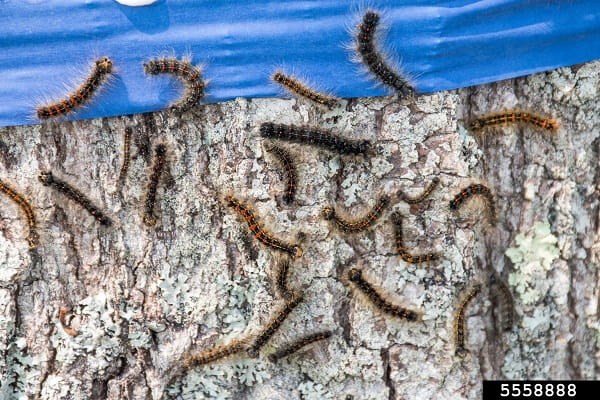The web Browser you are currently using is unsupported, and some features of this site may not work as intended. Please update to a modern browser such as Chrome, Firefox or Edge to experience all features Michigan.gov has to offer.
Some 're-leaf:' Limited and declining spongy moth populations continue in 2024
May 08, 2024

The warm spring weather means it’s time for open houses, outdoor weddings and picnics in the park. Sometimes, these occasions can be less fun with some uninvited guests – spongy moth caterpillars. Nature’s literal “party poopers,” these very hungry caterpillars cluster on oaks and other deciduous trees to munch on their leaves, raining BB-sized pellets of frass (droppings) on humans gathered below.
The good news for those planning outdoor events is that spongy moth populations will continue their downward trend in many areas in 2024. The outbreak that started in Michigan in 2019 and peaked in 2021 has been steadily declining for the last few years.
In 2023, the Department of Natural Resources conducted aerial surveys of nearly 20 million acres across the state, mapping 156,000 acres of defoliation, or leaf loss, due to spongy moth caterpillar feeding. While the number may seem high, it is less than half of the 386,000 acres recorded in 2022, and far short of the 1.3 million acres damaged in 2021.
The spongy moth population decline is expected to continue in 2024, with some defoliation likely in southwest Michigan, especially in areas of Allegan, Barry, Kalamazoo, Muskegon, Ottawa and Van Buren counties, where heavy infestations occurred over the last three years. Isolated areas of the central and western Upper Peninsula may also see defoliation in or near areas where defoliation occurred last year.
“Since the major outbreak in the early 1990’s, spongy moth populations have become cyclical, thanks in part to viral and fungal agents in the environment that spread quickly when caterpillar numbers are high, ultimately causing a population crash,” said Cheryl Nelson, DNR Forest Health forester. “While spongy moths don’t disappear entirely, the nuisance level is reduced to unnoticeable levels, allowing deciduous trees to enjoy eight to 12 years of healthy growth before the population builds again."
According to Michigan State University’s Enviroweather prediction model, spongy moth eggs should be hatching now in the Lower Peninsula. If spongy moth populations are a concern in your area, there are steps you can take.
Do what you can
Focus management in areas where caterpillars, their feeding or their frass will create the most problems.
- Before hatch, inspect decks, outdoor furniture, fences and trees, focusing on your favorite outdoor areas. Scrape any accessible egg masses into a bucket of soapy water or burn or bury them.
- After hatch, use a whisk broom to sweep young caterpillars into a bucket of soapy water. Let them soak overnight, then dispose.
- Make a tree trunk trap: Cut a band of burlap 18 inches wide and long enough to go around the tree trunk and overlap a bit. Tie a string around the center of the band to make a two-layered skirt around the trunk. When caterpillars climb trees daily to feed, they will get caught in the band. Scrape them into a bucket of soapy water to kill them.
If you choose to use a pesticide, use Btk (Bacillus thuringiensis var. kurstaki), which is highly effective on spongy moth but has little impact on beneficial insects. Btk works when caterpillars ingest it, so it should be applied to host tree leaves, not to the caterpillars themselves. It is most effective on young caterpillars and should be used within one to two weeks of hatch. Always follow label instructions to ensure safe pesticide application.
Be realistic
If you’re in an infested area, accept that it’s impossible to get rid of all spongy moth caterpillars. Consider cost, safety and environmental health in your management choices.
- Safety first! Avoid climbing or using ladders on unstable surfaces to reach egg masses or treat trees.
- Focus on protecting young or vulnerable trees or those most important to your landscape. A good watering at least once a week can help trees keep their vigor.
- Be sparing in pesticide use. Choose the right product in the right amount for the situation by following the label. Remember, in Michigan the label is the law!
- If you have large trees and feel they must be treated, hire a certified professional.
Don’t panic
- Remember that spongy moth outbreaks are cyclical and will collapse in one to three years, even without intervention.
- Caterpillars feed for about six to eight weeks, usually ceasing in midsummer.
- Affected hardwoods will typically releaf in mid- to late July, after suffering over 50% defoliation.
More information on spongy moth is available at Michigan.gov/Invasives.
A recording of the 2022 NotMISpecies webinar, “New name, familiar pest: Preparing for Lymantria dispar (formerly known as Gypsy moth)” is available for viewing at Michigan.gov/EGLE/Outreach.
If further information is needed, email questions to DNR-FRD-Forest-Health@Michigan.gov. Note that responses may be delayed due to high volume during the spring and summer.
Michigan's Invasive Species Program is cooperatively implemented by the Michigan departments of Agriculture and Rural Development; Environment, Great Lakes, and Energy; and Natural Resources.
Media Contact: